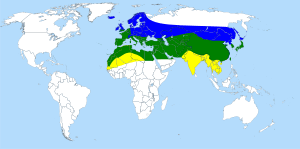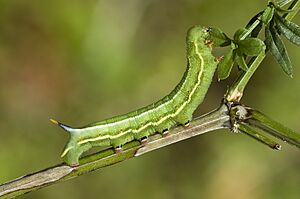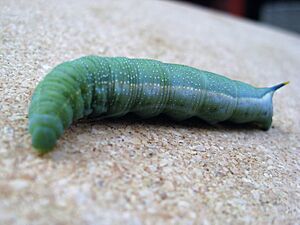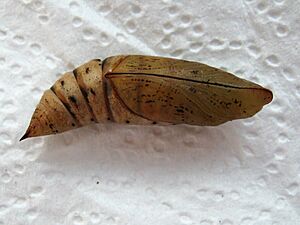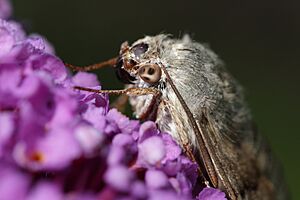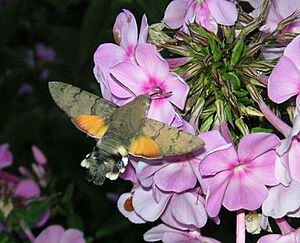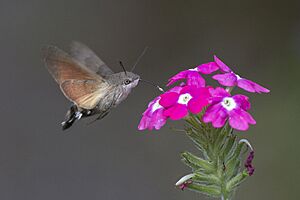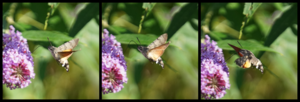Hummingbird hawk-moth facts for kids
Quick facts for kids Hummingbird hawk-moth |
|
|---|---|
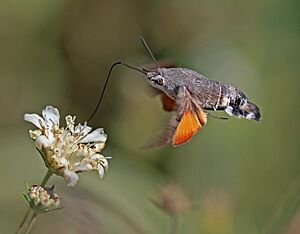 |
|
| In flight | |
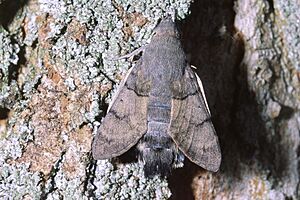 |
|
| At rest | |
| Scientific classification | |
| Synonyms | |
|
The hummingbird hawk-moth (Macroglossum stellatarum) is a fascinating type of hawk moth. You can find it in many parts of Eurasia, which includes Europe and Asia. This moth gets its name because it looks and acts a lot like a hummingbird! It sips nectar from long, tube-shaped flowers while hovering in the air. It uses a special long tongue called a proboscis. This similarity is a cool example of convergent evolution, where different animals develop similar traits because they live in similar ways.
The hummingbird hawk-moth was first described by a scientist named Carl Linnaeus in 1758. Scientists have even mapped out its entire genetic code!
Contents
Where Do Hummingbird Hawk-Moths Live?
These moths live across the northern Old World, from Portugal all the way to Japan. However, they mostly breed in warmer places like southern Europe and North Africa. In Spain, for example, they can have three generations of moths in one year.
Scientists have noticed that more hummingbird hawk-moths are appearing in Britain and Ireland. It seems they are even starting to stay there all year instead of migrating. This might be happening because of warmer temperatures from climate change, allowing them to survive the winter.
Hummingbird hawk-moths are strong flyers and can travel long distances in the summer. But they usually cannot survive the cold winters in northern areas, like north of the Alps mountains in Europe.
Sometimes, people confuse the hummingbird hawk-moth with other moths called "hummingbird moths" in North America. These are from a different group called Hemaris, but they are in the same moth family and look similar.
The Amazing Life Cycle of the Hummingbird Hawk-Moth
Hummingbird hawk-moths usually have two or more groups of babies (broods) each year. In warmer regions, you might see adult moths at any time, with three or four broods. They spend the winter as adults, hiding in cracks in rocks, trees, or buildings. On very warm winter days, they might even come out to feed!
Tiny Eggs (Ova)
The eggs, called ova, are shiny and pale green. They are round and about 1 millimeter (0.04 inches) wide. They are said to look like the flower buds of the plant where the mother moth lays them. The female moth lays each egg on a different plant. A single female can lay up to 200 eggs! The eggs hatch into tiny caterpillars in about 6 to 8 days.
Growing Caterpillars (Larvae)
When the caterpillars, or larvae, first hatch, they are clear yellow. After their first growth stage, they turn green. The caterpillar is green with two gray stripes along its sides, outlined in cream. It also has a small horn at its rear end, which is common for hawk-moth caterpillars. This horn is purplish-red, and in its final stage, it turns blue with an orange tip.
These caterpillars feed openly on the top of their host plants. They like to rest among tangled stems. If it's warm and sunny, the caterpillar stage can be as short as 20 days.
Resting Stage (Pupae)
The pupae are light brownish. They have a noticeable, ridged proboscis (the future long tongue) and two sharp spines at the end of their tail part, called a cremaster. They rest inside loose silken cocoons. These cocoons are often found among plant bits or on the ground in leaf litter.
Adult Moths Take Flight
The adult moths have brown front wings with wavy black lines. Their back wings are orange with a black edge. Their body is quite wide, and they have a fan-like tail made of stiff hairs called setae. Their wingspan, which is the distance from wingtip to wingtip, is about 40 to 45 millimeters (1.6 to 1.8 inches).
In warmer areas, these moths are very active even when it's hot. Their body temperature can reach over 45 degrees Celsius (113 degrees Fahrenheit)! This is one of the highest temperatures recorded for hawk-moths and is almost too hot for insect muscles to work.
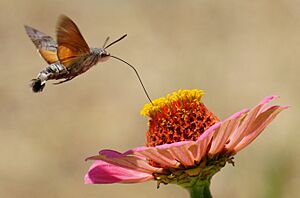
How Hummingbird Hawk-Moths Behave and Fly
The hummingbird hawk-moth has a long proboscis, about 25–28 millimeters (1 inch) long. It also hovers in the air, making a humming sound. These traits make it look incredibly similar to a hummingbird when it feeds on flowers. Just like hummingbirds, it prefers flowers with tube-shaped petals, called corollae.
Remember, this moth should not be confused with the "hummingbird moths" found in North America. Those are from a different group, Hemaris, but they belong to the same moth family and share similar looks and actions. The way this moth looks like a hummingbird is a great example of convergent evolution. This means two different species developed similar features independently.
These moths fly during the day, especially in bright sunshine. But they also fly at dusk, dawn, and even in the rain! This is quite unusual for moths that are active during the day. The hummingbird hawk-moth can hover freely in the air. This gives it great control and allows it to move easily, even though it uses a lot of energy. Like many large insects, it uses special organs called Johnston's organs to help it know its body's position in the air.
Super Sight: How Hummingbird Hawk-Moths See
Scientists have studied the hummingbird hawk-moth's eyesight a lot. They found that these moths are very good at learning and telling colors apart. They have a trichromatic visual system, which means they see colors using three different types of light receptors, similar to humans. They are most sensitive to light wavelengths between 349 and 521 nanometers.
These moths can even tell the difference between colors that are only 1 or 2 nanometers apart! This is even more precise than the vision of a honey bee. Their eyesight is similar to the Asian swallowtail butterfly and the nocturnal elephant hawk-moth.
Hummingbird hawk-moths choose their food mainly by sight. Other moths, like the elephant hawk-moth, rely more on smell. Compared to the elephant hawk-moth, hummingbird hawk-moths have fewer tiny eye units called ommatidia. However, they have a larger part of their brain dedicated to processing visual information.
Favorite Homes and Food of the Hummingbird Hawk-Moth
You can easily spot hummingbird hawk-moths in many places. Look for them in gardens, parks, meadows, bushes, and along the edges of forests. These are places where their favorite food plants grow, such as honeysuckle and red valerian.
Their caterpillars usually eat plants like bedstraws or madders. But they have also been seen eating other plants from the same family, as well as Centranthus, Stellaria, and Epilobium.
Adult moths especially love flowers that are rich in nectar and have a long, narrow calyx (the outer part of the flower). Their long proboscis lets them reach the nectar deep inside these flowers, avoiding competition from other insects. Flowers with longer tubes often offer more nectar. It's thought that the length of the moths' proboscis has changed over time to match the length of these flower tubes.
Some of their favorite flowers include Centranthus, Jasminum, Buddleia, Nicotiana, Primula, Viola, Syringa, Verbena, Echium, Phlox, and Stachys. These moths are known to "trap-line." This means they often visit the same flower beds around the same time each day.
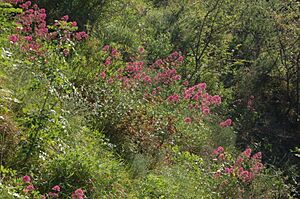
Hummingbird Hawk-Moths in Stories and History
Hummingbird hawk-moths have sometimes been seen as a sign of good luck! For example, a large group of these moths was seen flying across the English Channel on D-Day. This was the day of the Normandy landings during the Second World War.
These moths, along with others in the Sphingidae family, were named because their caterpillars were thought to look like the ancient Egyptian Sphinx. The band They Might Be Giants even has a song called "The Bee of the Bird of the Moth" which is about the hummingbird moth!


